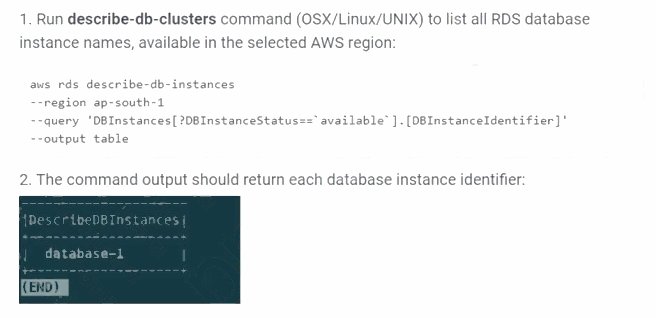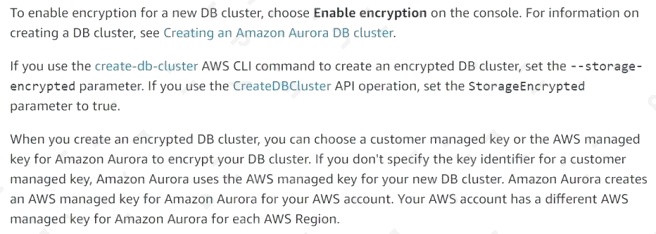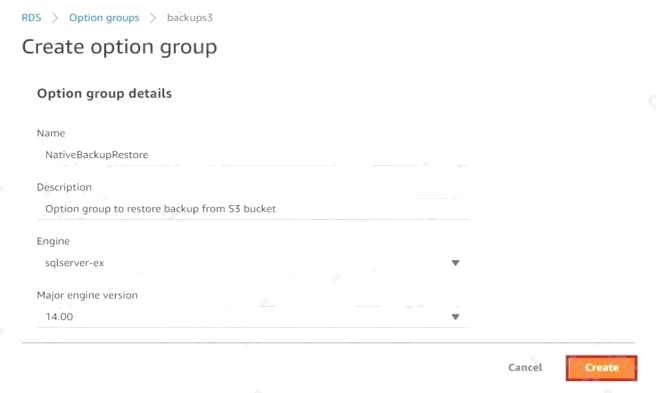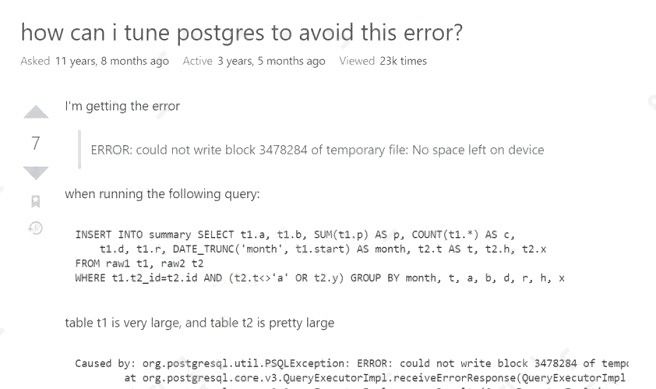You can't convert an unencrypted DB cluster to an encrypted one. However, you can restore an unencrypted snapshot to an encrypted Aurora DB cluster. To do this, specify a KMS key when you restore from the unencrypted snapshot.
A database specialist needs to review and optimize an Amazon DynamoDB table that is experiencing performance issues. A
thorough investigation by the database specialist reveals that the partition key is causing hot partitions, so a new partition
key is created. The database specialist must effectively apply this new partition key to all existing and new data.
How can this solution be implemented?
D
A database specialist is designing an enterprise application for a large company. The application uses Amazon DynamoDB
with DynamoDB Accelerator (DAX). The database specialist observes that most of the queries are not found in the DAX
cache and that they still require DynamoDB table reads.
What should the database specialist review first to improve the utility of DAX?
A
Explanation:
Reference: https://docs.aws.amazon.com/amazondynamodb/latest/developerguide/metrics-dimensions.html
A company is developing an application that performs intensive in-memory operations on advanced data structures such as
sorted sets. The application requires sub-millisecond latency for reads and writes. The application occasionally must run a
group of commands as an ACID-compliant operation. A database specialist is setting up the database for this application.
The database specialist needs the ability to create a new database cluster from the latest backup of the production cluster.
Which type of cluster should the database specialist create to meet these requirements?
D
Explanation:
Reference: https://aws.amazon.com/blogs/database/how-to-determine-if-amazon-dynamodb-is-appropriate-for-your-needs-
and-then-plan-your-migration/
A company is developing a multi-tier web application hosted on AWS using Amazon Aurora as the database. The application
needs to be deployed to production and other non-production environments. A Database Specialist needs to specify different
MasterUsername and MasterUserPassword properties in the AWS CloudFormation templates used for automated
deployment. The CloudFormation templates are version controlled in the companys code repository. The company also
needs to meet compliance requirement by routinely rotating its database master password for production. What is most
secure solution to store the master password?
C
A financial company wants to store sensitive user data in an Amazon Aurora PostgreSQL DB cluster. The database will be
accessed by multiple applications across the company. The company has mandated that all communications to the database
be encrypted and the server identity must be validated. Any non-SSL-based connections should be disallowed access to the
database.
Which solution addresses these requirements?
D
Explanation:
Reference: https://forums.aws.amazon.com/message.jspa?messageID=734076
An application reads and writes data to an Amazon RDS for MySQL DB instance. A new reporting dashboard needs read-
only access to the database. When the application and reports are both under heavy load, the database experiences
performance degradation. A database specialist needs to improve the database performance.
What should the database specialist do to meet these requirements?
C
Explanation:
Reference: https://www.nops.io/enable-multi-az-for-rds-instances/
A finance company migrated its 3 on-premises PostgreSQL database to an Amazon Aurora PostgreSQL DB cluster.
During a review after the migration, a database specialist discovers that the database is not encrypted at rest. The database
must be encrypted at rest as soon as possible to meet security requirements. The database specialist must enable
encryption for the DB cluster with minimal downtime.
Which solution will meet these requirements?
A
Explanation:
To enable encryption for a new DB cluster, choose Enable encryption on the console. For information on creating a DB
cluster.
Reference: https://docs.aws.amazon.com/AmazonRDS/latest/AuroraUserGuide/Overview.Encryption.html
You can't convert an unencrypted DB cluster to an encrypted one. However, you can restore an unencrypted snapshot to an encrypted Aurora DB cluster. To do this, specify a KMS key when you restore from the unencrypted snapshot.
A retail company with its main office in New York and another office in Tokyo plans to build a database solution on AWS.
The companys main workload consists of a mission-critical application that updates its application data in a data store. The
team at the Tokyo office is building dashboards with complex analytical queries using the application data. The dashboards
will be used to make buying decisions, so they need to have access to the application data in less than 1 second. Which
solution meets these requirements?
D
A large ecommerce company uses Amazon DynamoDB to handle the transactions on its web portal. Traffic patterns
throughout the year are usually stable; however, a large event is planned. The company knows that traffic will increase by up
to 10 times the normal load over the 3-day event. When sale prices are published during the event, traffic will spike rapidly.
How should a Database Specialist ensure DynamoDB can handle the increased traffic?
B
A company has a database fleet that includes an Amazon RDS for MySQL DB instance. During an audit, the company
discovered that the data that is stored on the DB instance is unencrypted.
A database specialist must enable encryption for the DB instance. The database specialist also must encrypt all connections
to the DB instance.
Which combination of actions should the database specialist take to meet these requirements? (Choose three.)
A E F
Explanation:
Reference: https://docs.aws.amazon.com/AmazonRDS/latest/UserGuide/Overview.Encryption.html
A company has an on-premises production Microsoft SQL Server with 250 GB of data in one database. A database
specialist needs to migrate this on-premises SQL Server to Amazon RDS for SQL Server. The nightly native SQL Server
backup file is approximately 120 GB in size. The application can be down for an extended period of time to complete the
migration. Connectivity between the onpremises environment and AWS can be initiated from on-premises only.
How can the database be migrated from on-premises to Amazon RDS with the LEAST amount of effort?
B
Explanation:
Reference: https://www.sqlshack.com/aws-rds-sql-server-migration-using-native-backups/
A Database Specialist is setting up a new Amazon Aurora DB cluster with one primary instance and three Aurora Replicas
for a highly intensive, business-critical application. The Aurora DB cluster has one medium-sized primary instance, one
large-sized replica, and two medium sized replicas. The Database Specialist did not assign a promotion tier to the replicas.
In the event of a primary failure, what will occur?
A
Explanation:
Reference: https://docs.aws.amazon.com/AmazonRDS/latest/AuroraUserGuide/aurora-ug.pdf
A company is going through a security audit. The audit team has identified cleartext master user password in the AWS
CloudFormation templates for Amazon RDS for MySQL DB instances. The audit team has flagged this as a security risk to
the database team.
What should a database specialist do to mitigate this risk?
C
A Database Specialist is performing a proof of concept with Amazon Aurora using a small instance to confirm a simple
database behavior. When loading a large dataset and creating the index, the Database Specialist encounters the following
error message from Aurora:
ERROR: cloud not write block 7507718 of temporary file: No space left on device
What is the cause of this error and what should the Database Specialist do to resolve this issue?
C
Explanation:
Reference: https://serverfault.com/questions/109828/how-can-i-tune-postgres-to-avoid-this-error
A database specialist wants to ensure that an Amazon Aurora DB cluster is always automatically upgraded to the most
recent minor version available. Noticing that there is a new minor version available, the database specialist has issues an
AWS CLI command to enable automatic minor version updates. The command runs successfully, but checking the Aurora
DB cluster indicates that no update to the Aurora version has been made.
What might account for this? (Choose two.)
C D